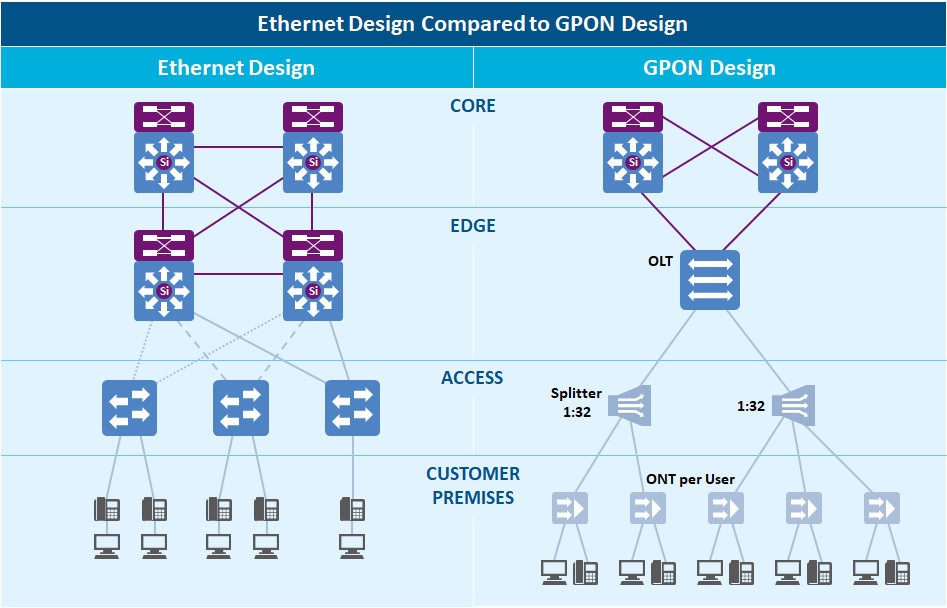Rolling out FTTP: The B2B Business Case for GPON
By Vito Morawetz
Insatiable consumer demand for high-speed broadband services has sparked a global wave of investment supporting roll-out of access networks. New FTTP networks, and the expansion and upgrade of existing networks, are rapidly increasing the availability of gigabit-capable broadband services.
FTTP coverage is increasingly reaching areas with significant presence of business premises, as well as residential areas.
Most FTTP networks are being built based on a Gigabit Passive Optical Network (GPON) architecture, which involves fewer active network elements (e.g. Ethernet switches) compared to a typical multi-site Enterprise Ethernet network design. GPON design has routing and service management functions concentrated at the core of the network, and passive optical devices providing distribution to customer location in a hub-and-spoke topology.

Source: Cartesian
Traditionally, GPON architecture has mostly been used to provide residential services, while business customers have generally opted for Ethernet services, which offer guaranteed symmetrical bandwidth, routing flexibility, and VLAN management.
Most businesses today still rely on Ethernet design to satisfy their networking needs, and many service providers can enjoy relatively stable and long-lasting customer relationships due to the cost and complexity of migrating to alternative networks on a like-for-like basis.
The suitability of GPON architecture for B2B
Nonetheless, key technology and market developments are making GPON-based products increasingly suitable for many business applications, and are therefore being considered by business customers as a possible alternative to traditional Ethernet-based leased lines:
1. Increasing bandwidths
GPON technology is evolving towards Next Generation capabilities, with higher bandwidths of 10/20Gpbs (XGPON) — with up to 100Gbps on a single wavelength being trialed in lab environment – symmetrical speeds (XGSPON) and better VLAN-aware Optical Line Terminals, hence addressing some of the main limitations to GPON use in a business environment.
2. Shared infrastructure costs
FTTP networks with mixed residential and business coverage, are sharing infrastructure and build costs across large numbers of premises, generating better economies of scale and scope compared to business-only point-to-point infrastructure supporting Ethernet leased lines services. These economies of scale and scope are increasingly flowing through to attractive retail pricing for 1Gbps GPON connections compared to Ethernet leased line equivalents.
3. The transition to Cloud
Many businesses are transitioning from traditional enterprise-wide area networks (WANs) — based on multiple sites interconnected with each other in a “mesh” – to cloud-based solutions. In a cloud-centric architecture, the application, services, and network intelligence are often centralized in external Data Centers that can be accessed by individual users on point-to-point connections, in a sort of “Virtual Campus” environment, which can be efficiently served by a GPON architecture.
These developments are making GPON architecture much more attractive for delivering enterprise services. For companies considering developing a Next Generation GPON proposition for servicing their business customers, here are some factors to consider:
- Service transition and upgrade from Ethernet to GPON-based services requires a specific product migration proposition so that customers transforming their WAN can do so in a controlled and seamless fashion;
- It is critical to analyse in detail the customer characteristics and requirements to identify customers that would most benefit from a transition to Next Generation GPON services; and,
- Economies of scale and scope of an FTTP roll-out are maximized if residential and B2B opportunities are considered jointly in planning and deploying new networks.
Cartesian has a broad set of capabilities and expertise to support Enterprise Service Providers to develop strategies to navigate risks and opportunities brought by Next Generation GPON developments.
- We have a tried and tested and holistic Product Transformation approach that can support the development and positioning of GPON-based services within the Enterprise product portfolio, including specific product migration propositions for those customers that wish to transition from their existing Ethernet services to a GPON proposition;
- We have an extensive track record in Advanced Sales Analytics for the Telco industry. We can rapidly capture and analyse data related to multiple characteristics of existing customer base (e.g. bandwidth currently purchased and utilised, customer site characteristics, uptake of Cloud/UC services, customer sectors, etc.) to develop customer segmentation and a predictive product recommendations capability for both “defensive” and “aggressive” commercial purposes, i.e. identifying existing customers that could be more inclined to take on GPON services, as well identifying market segments where customers could be won from the competition;
- We can leverage our experience in Geospatial Analysis in support of network expansion to integrate and map B2B customer segmentation data and B2B site characteristics (most importantly MDUs and campus-style locations) in FTTP roll-out and expansion plans to assess and maximise B2B opportunities in GPON infrastructure footprint.<>
Would you like to learn more about how we can help with your enterprise network strategy? Contact us here.




